Australian Commercial Law Assignment: Contractual Issues and Remedies
VerifiedAdded on 2021/06/14
|10
|2510
|32
Homework Assignment
AI Summary
This document provides a detailed solution to an Australian Commercial Law assignment. The assignment analyzes a scenario involving a business purchase contract where the buyer, Barry, alleges misrepresentation by the seller, Angelo. The solution begins with a summary of a tribal constitution, highlighting principles of fairness, equality, and dispute resolution based on Hart's legal theory. It then addresses the core legal issue: whether Barry can challenge the contract's validity due to Angelo's pre-contractual statements. The analysis delves into the rules regarding pre-contractual statements, misrepresentation under the Australian Consumer Law (ACL), and the concept of materiality and reliance. The document concludes by examining the available actions for Barry in case of a breach of contract, including rescission and damages, providing relevant case law and applying the legal principles to the facts of the case. The assignment showcases the interplay of contract law, misrepresentation, and remedies in a commercial context.
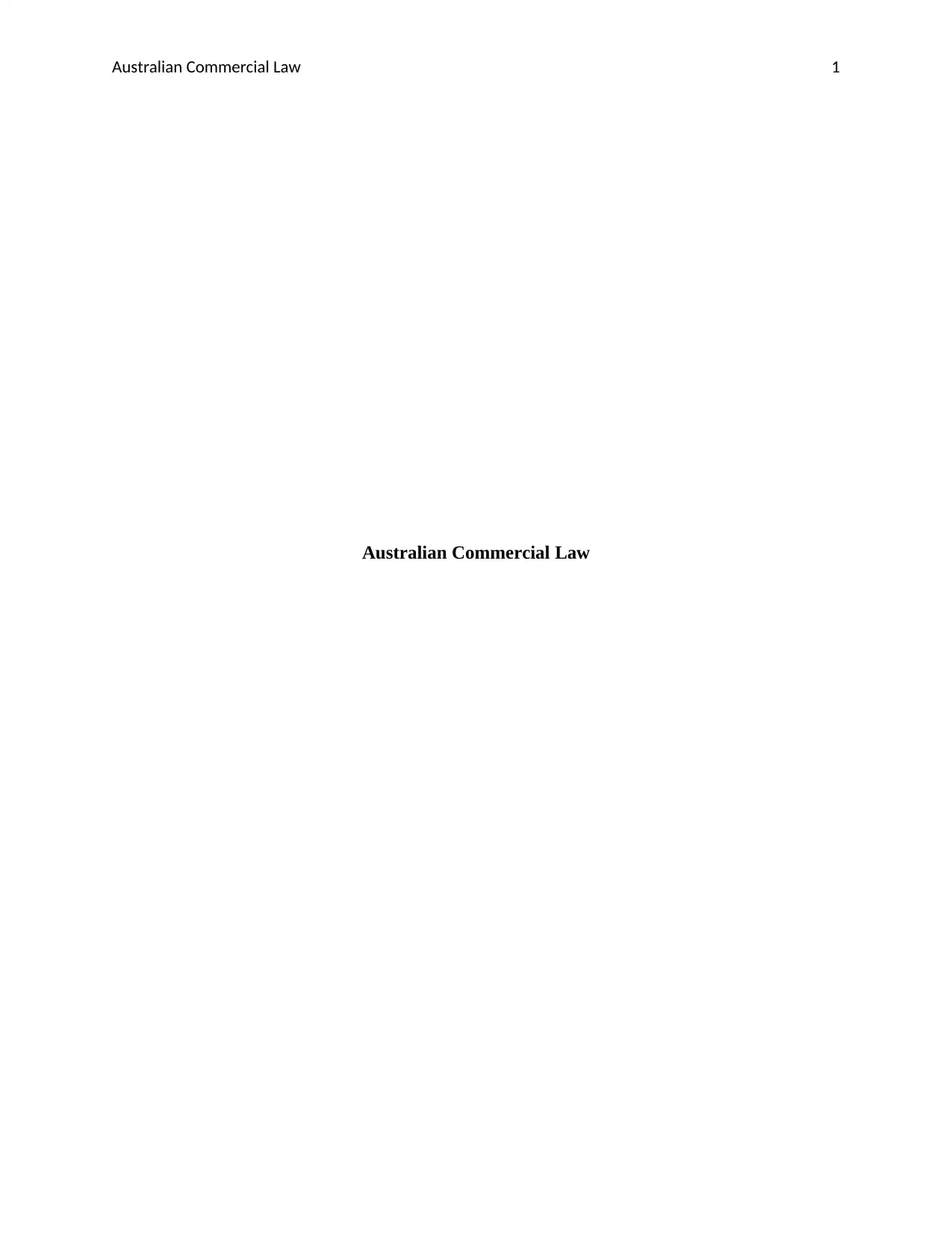
Australian Commercial Law 1
Australian Commercial Law
Australian Commercial Law
Paraphrase This Document
Need a fresh take? Get an instant paraphrase of this document with our AI Paraphraser
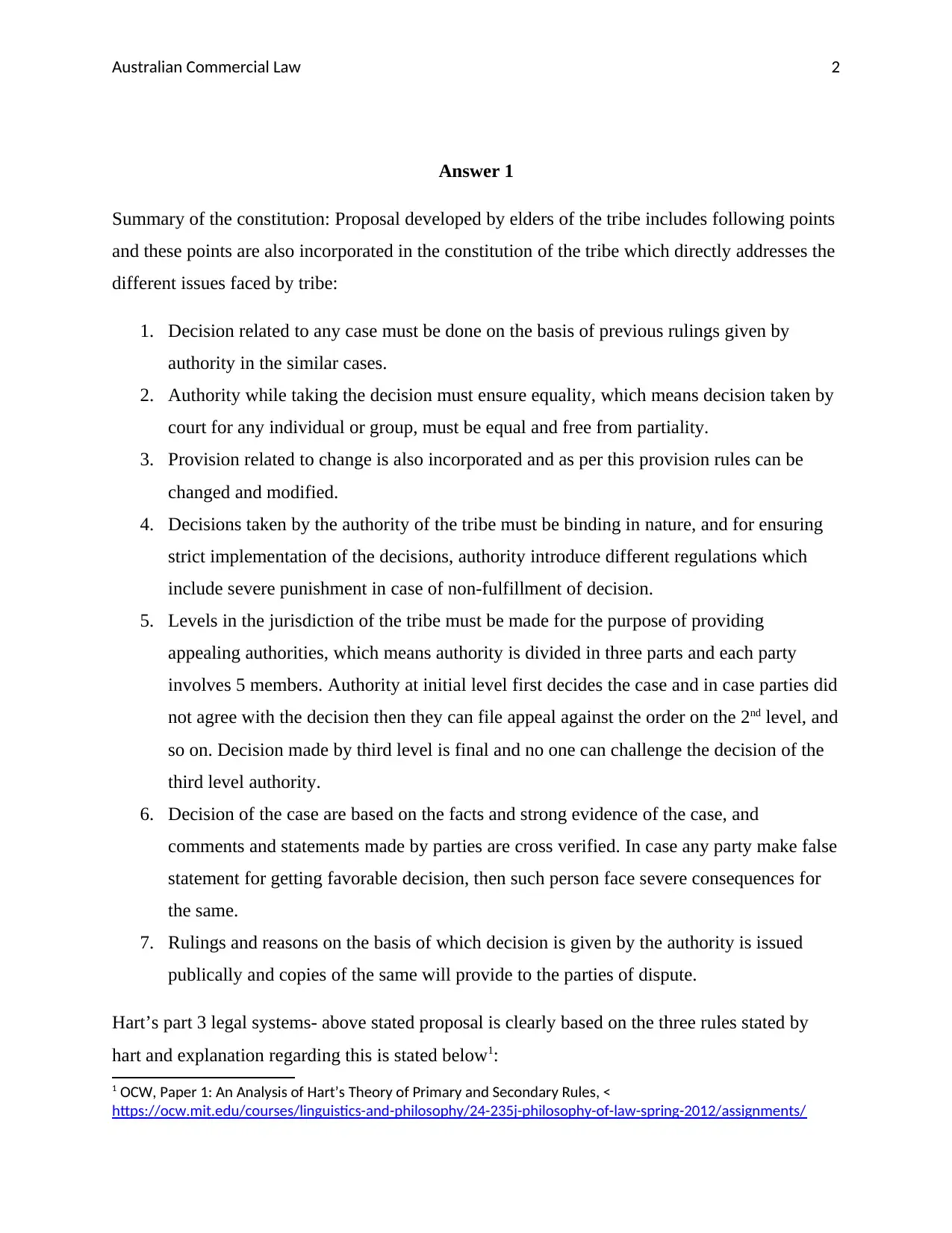
Australian Commercial Law 2
Answer 1
Summary of the constitution: Proposal developed by elders of the tribe includes following points
and these points are also incorporated in the constitution of the tribe which directly addresses the
different issues faced by tribe:
1. Decision related to any case must be done on the basis of previous rulings given by
authority in the similar cases.
2. Authority while taking the decision must ensure equality, which means decision taken by
court for any individual or group, must be equal and free from partiality.
3. Provision related to change is also incorporated and as per this provision rules can be
changed and modified.
4. Decisions taken by the authority of the tribe must be binding in nature, and for ensuring
strict implementation of the decisions, authority introduce different regulations which
include severe punishment in case of non-fulfillment of decision.
5. Levels in the jurisdiction of the tribe must be made for the purpose of providing
appealing authorities, which means authority is divided in three parts and each party
involves 5 members. Authority at initial level first decides the case and in case parties did
not agree with the decision then they can file appeal against the order on the 2nd level, and
so on. Decision made by third level is final and no one can challenge the decision of the
third level authority.
6. Decision of the case are based on the facts and strong evidence of the case, and
comments and statements made by parties are cross verified. In case any party make false
statement for getting favorable decision, then such person face severe consequences for
the same.
7. Rulings and reasons on the basis of which decision is given by the authority is issued
publically and copies of the same will provide to the parties of dispute.
Hart’s part 3 legal systems- above stated proposal is clearly based on the three rules stated by
hart and explanation regarding this is stated below1:
1 OCW, Paper 1: An Analysis of Hart’s Theory of Primary and Secondary Rules, <
https://ocw.mit.edu/courses/linguistics-and-philosophy/24-235j-philosophy-of-law-spring-2012/assignments/
Answer 1
Summary of the constitution: Proposal developed by elders of the tribe includes following points
and these points are also incorporated in the constitution of the tribe which directly addresses the
different issues faced by tribe:
1. Decision related to any case must be done on the basis of previous rulings given by
authority in the similar cases.
2. Authority while taking the decision must ensure equality, which means decision taken by
court for any individual or group, must be equal and free from partiality.
3. Provision related to change is also incorporated and as per this provision rules can be
changed and modified.
4. Decisions taken by the authority of the tribe must be binding in nature, and for ensuring
strict implementation of the decisions, authority introduce different regulations which
include severe punishment in case of non-fulfillment of decision.
5. Levels in the jurisdiction of the tribe must be made for the purpose of providing
appealing authorities, which means authority is divided in three parts and each party
involves 5 members. Authority at initial level first decides the case and in case parties did
not agree with the decision then they can file appeal against the order on the 2nd level, and
so on. Decision made by third level is final and no one can challenge the decision of the
third level authority.
6. Decision of the case are based on the facts and strong evidence of the case, and
comments and statements made by parties are cross verified. In case any party make false
statement for getting favorable decision, then such person face severe consequences for
the same.
7. Rulings and reasons on the basis of which decision is given by the authority is issued
publically and copies of the same will provide to the parties of dispute.
Hart’s part 3 legal systems- above stated proposal is clearly based on the three rules stated by
hart and explanation regarding this is stated below1:
1 OCW, Paper 1: An Analysis of Hart’s Theory of Primary and Secondary Rules, <
https://ocw.mit.edu/courses/linguistics-and-philosophy/24-235j-philosophy-of-law-spring-2012/assignments/
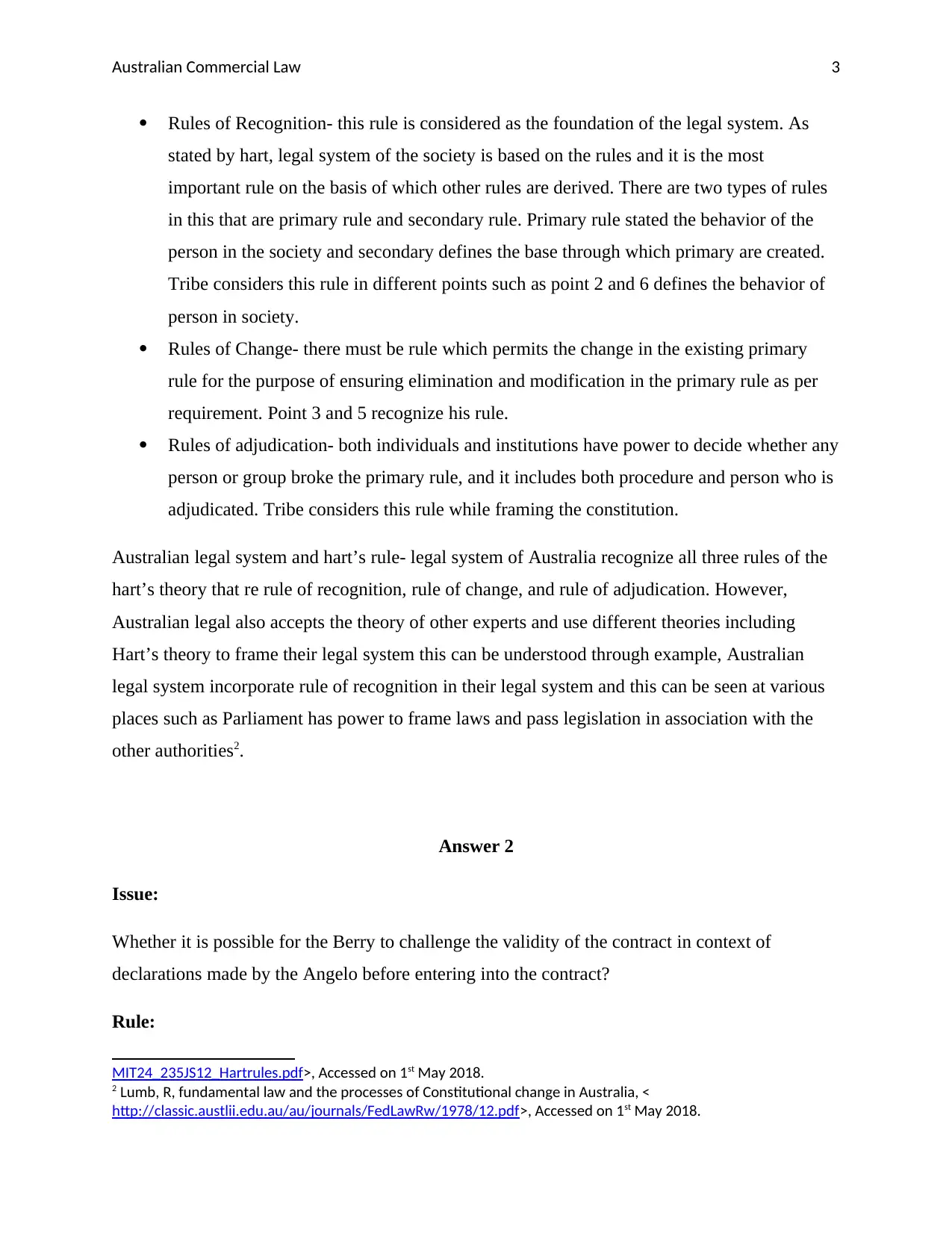
Australian Commercial Law 3
Rules of Recognition- this rule is considered as the foundation of the legal system. As
stated by hart, legal system of the society is based on the rules and it is the most
important rule on the basis of which other rules are derived. There are two types of rules
in this that are primary rule and secondary rule. Primary rule stated the behavior of the
person in the society and secondary defines the base through which primary are created.
Tribe considers this rule in different points such as point 2 and 6 defines the behavior of
person in society.
Rules of Change- there must be rule which permits the change in the existing primary
rule for the purpose of ensuring elimination and modification in the primary rule as per
requirement. Point 3 and 5 recognize his rule.
Rules of adjudication- both individuals and institutions have power to decide whether any
person or group broke the primary rule, and it includes both procedure and person who is
adjudicated. Tribe considers this rule while framing the constitution.
Australian legal system and hart’s rule- legal system of Australia recognize all three rules of the
hart’s theory that re rule of recognition, rule of change, and rule of adjudication. However,
Australian legal also accepts the theory of other experts and use different theories including
Hart’s theory to frame their legal system this can be understood through example, Australian
legal system incorporate rule of recognition in their legal system and this can be seen at various
places such as Parliament has power to frame laws and pass legislation in association with the
other authorities2.
Answer 2
Issue:
Whether it is possible for the Berry to challenge the validity of the contract in context of
declarations made by the Angelo before entering into the contract?
Rule:
MIT24_235JS12_Hartrules.pdf>, Accessed on 1st May 2018.
2 Lumb, R, fundamental law and the processes of Constitutional change in Australia, <
http://classic.austlii.edu.au/au/journals/FedLawRw/1978/12.pdf>, Accessed on 1st May 2018.
Rules of Recognition- this rule is considered as the foundation of the legal system. As
stated by hart, legal system of the society is based on the rules and it is the most
important rule on the basis of which other rules are derived. There are two types of rules
in this that are primary rule and secondary rule. Primary rule stated the behavior of the
person in the society and secondary defines the base through which primary are created.
Tribe considers this rule in different points such as point 2 and 6 defines the behavior of
person in society.
Rules of Change- there must be rule which permits the change in the existing primary
rule for the purpose of ensuring elimination and modification in the primary rule as per
requirement. Point 3 and 5 recognize his rule.
Rules of adjudication- both individuals and institutions have power to decide whether any
person or group broke the primary rule, and it includes both procedure and person who is
adjudicated. Tribe considers this rule while framing the constitution.
Australian legal system and hart’s rule- legal system of Australia recognize all three rules of the
hart’s theory that re rule of recognition, rule of change, and rule of adjudication. However,
Australian legal also accepts the theory of other experts and use different theories including
Hart’s theory to frame their legal system this can be understood through example, Australian
legal system incorporate rule of recognition in their legal system and this can be seen at various
places such as Parliament has power to frame laws and pass legislation in association with the
other authorities2.
Answer 2
Issue:
Whether it is possible for the Berry to challenge the validity of the contract in context of
declarations made by the Angelo before entering into the contract?
Rule:
MIT24_235JS12_Hartrules.pdf>, Accessed on 1st May 2018.
2 Lumb, R, fundamental law and the processes of Constitutional change in Australia, <
http://classic.austlii.edu.au/au/journals/FedLawRw/1978/12.pdf>, Accessed on 1st May 2018.
⊘ This is a preview!⊘
Do you want full access?
Subscribe today to unlock all pages.

Trusted by 1+ million students worldwide
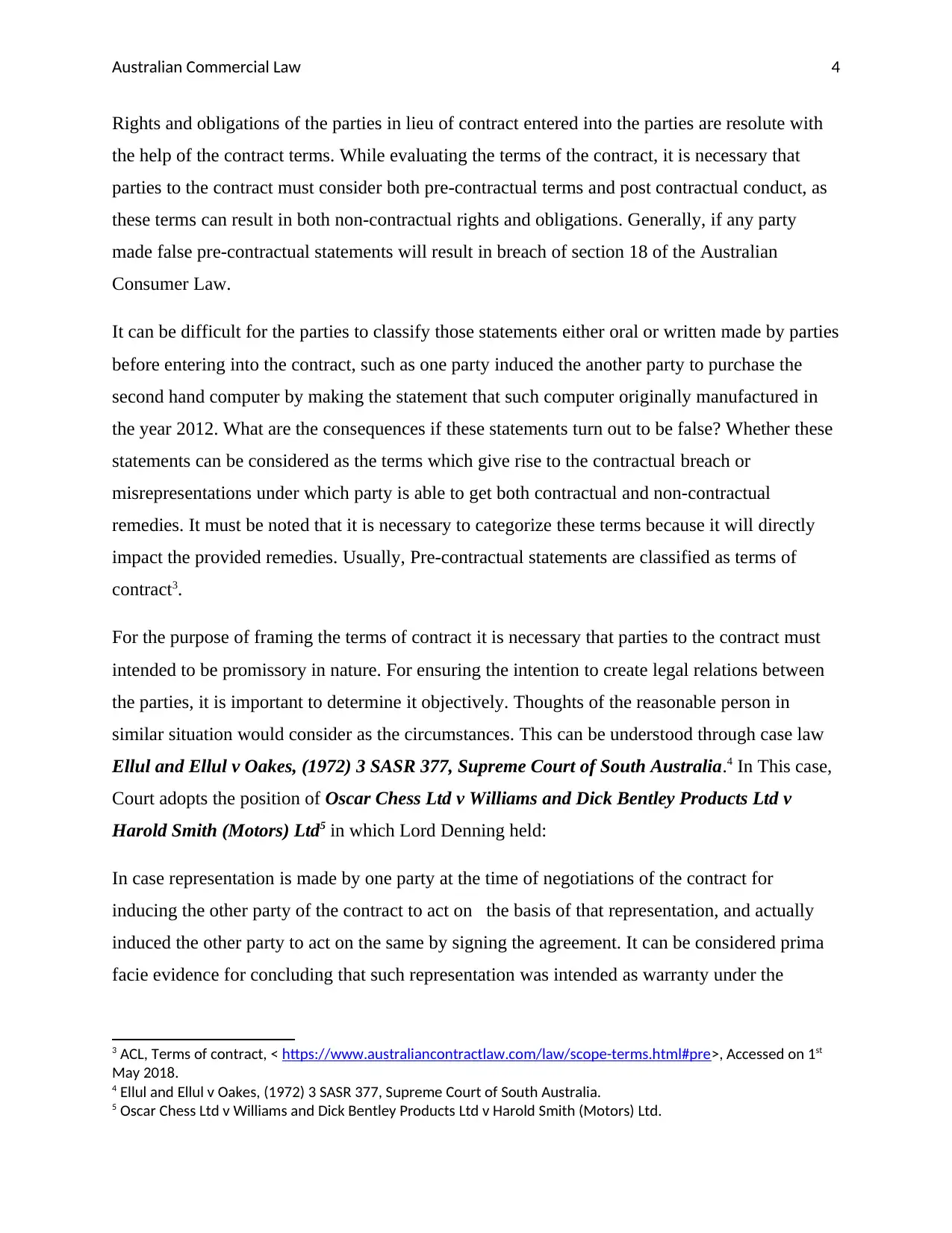
Australian Commercial Law 4
Rights and obligations of the parties in lieu of contract entered into the parties are resolute with
the help of the contract terms. While evaluating the terms of the contract, it is necessary that
parties to the contract must consider both pre-contractual terms and post contractual conduct, as
these terms can result in both non-contractual rights and obligations. Generally, if any party
made false pre-contractual statements will result in breach of section 18 of the Australian
Consumer Law.
It can be difficult for the parties to classify those statements either oral or written made by parties
before entering into the contract, such as one party induced the another party to purchase the
second hand computer by making the statement that such computer originally manufactured in
the year 2012. What are the consequences if these statements turn out to be false? Whether these
statements can be considered as the terms which give rise to the contractual breach or
misrepresentations under which party is able to get both contractual and non-contractual
remedies. It must be noted that it is necessary to categorize these terms because it will directly
impact the provided remedies. Usually, Pre-contractual statements are classified as terms of
contract3.
For the purpose of framing the terms of contract it is necessary that parties to the contract must
intended to be promissory in nature. For ensuring the intention to create legal relations between
the parties, it is important to determine it objectively. Thoughts of the reasonable person in
similar situation would consider as the circumstances. This can be understood through case law
Ellul and Ellul v Oakes, (1972) 3 SASR 377, Supreme Court of South Australia.4 In This case,
Court adopts the position of Oscar Chess Ltd v Williams and Dick Bentley Products Ltd v
Harold Smith (Motors) Ltd5 in which Lord Denning held:
In case representation is made by one party at the time of negotiations of the contract for
inducing the other party of the contract to act on the basis of that representation, and actually
induced the other party to act on the same by signing the agreement. It can be considered prima
facie evidence for concluding that such representation was intended as warranty under the
3 ACL, Terms of contract, < https://www.australiancontractlaw.com/law/scope-terms.html#pre>, Accessed on 1st
May 2018.
4 Ellul and Ellul v Oakes, (1972) 3 SASR 377, Supreme Court of South Australia.
5 Oscar Chess Ltd v Williams and Dick Bentley Products Ltd v Harold Smith (Motors) Ltd.
Rights and obligations of the parties in lieu of contract entered into the parties are resolute with
the help of the contract terms. While evaluating the terms of the contract, it is necessary that
parties to the contract must consider both pre-contractual terms and post contractual conduct, as
these terms can result in both non-contractual rights and obligations. Generally, if any party
made false pre-contractual statements will result in breach of section 18 of the Australian
Consumer Law.
It can be difficult for the parties to classify those statements either oral or written made by parties
before entering into the contract, such as one party induced the another party to purchase the
second hand computer by making the statement that such computer originally manufactured in
the year 2012. What are the consequences if these statements turn out to be false? Whether these
statements can be considered as the terms which give rise to the contractual breach or
misrepresentations under which party is able to get both contractual and non-contractual
remedies. It must be noted that it is necessary to categorize these terms because it will directly
impact the provided remedies. Usually, Pre-contractual statements are classified as terms of
contract3.
For the purpose of framing the terms of contract it is necessary that parties to the contract must
intended to be promissory in nature. For ensuring the intention to create legal relations between
the parties, it is important to determine it objectively. Thoughts of the reasonable person in
similar situation would consider as the circumstances. This can be understood through case law
Ellul and Ellul v Oakes, (1972) 3 SASR 377, Supreme Court of South Australia.4 In This case,
Court adopts the position of Oscar Chess Ltd v Williams and Dick Bentley Products Ltd v
Harold Smith (Motors) Ltd5 in which Lord Denning held:
In case representation is made by one party at the time of negotiations of the contract for
inducing the other party of the contract to act on the basis of that representation, and actually
induced the other party to act on the same by signing the agreement. It can be considered prima
facie evidence for concluding that such representation was intended as warranty under the
3 ACL, Terms of contract, < https://www.australiancontractlaw.com/law/scope-terms.html#pre>, Accessed on 1st
May 2018.
4 Ellul and Ellul v Oakes, (1972) 3 SASR 377, Supreme Court of South Australia.
5 Oscar Chess Ltd v Williams and Dick Bentley Products Ltd v Harold Smith (Motors) Ltd.
Paraphrase This Document
Need a fresh take? Get an instant paraphrase of this document with our AI Paraphraser
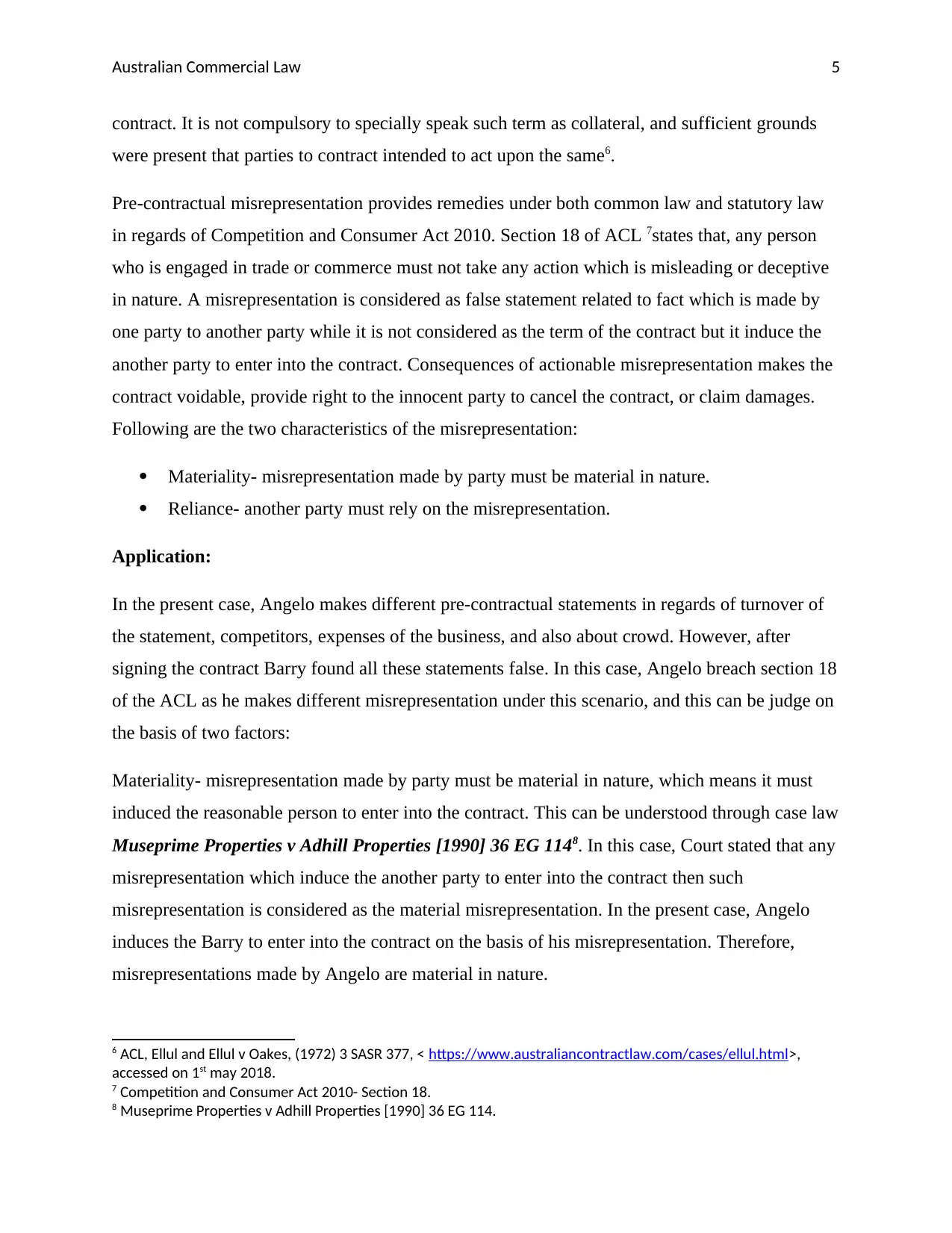
Australian Commercial Law 5
contract. It is not compulsory to specially speak such term as collateral, and sufficient grounds
were present that parties to contract intended to act upon the same6.
Pre-contractual misrepresentation provides remedies under both common law and statutory law
in regards of Competition and Consumer Act 2010. Section 18 of ACL 7states that, any person
who is engaged in trade or commerce must not take any action which is misleading or deceptive
in nature. A misrepresentation is considered as false statement related to fact which is made by
one party to another party while it is not considered as the term of the contract but it induce the
another party to enter into the contract. Consequences of actionable misrepresentation makes the
contract voidable, provide right to the innocent party to cancel the contract, or claim damages.
Following are the two characteristics of the misrepresentation:
Materiality- misrepresentation made by party must be material in nature.
Reliance- another party must rely on the misrepresentation.
Application:
In the present case, Angelo makes different pre-contractual statements in regards of turnover of
the statement, competitors, expenses of the business, and also about crowd. However, after
signing the contract Barry found all these statements false. In this case, Angelo breach section 18
of the ACL as he makes different misrepresentation under this scenario, and this can be judge on
the basis of two factors:
Materiality- misrepresentation made by party must be material in nature, which means it must
induced the reasonable person to enter into the contract. This can be understood through case law
Museprime Properties v Adhill Properties [1990] 36 EG 1148. In this case, Court stated that any
misrepresentation which induce the another party to enter into the contract then such
misrepresentation is considered as the material misrepresentation. In the present case, Angelo
induces the Barry to enter into the contract on the basis of his misrepresentation. Therefore,
misrepresentations made by Angelo are material in nature.
6 ACL, Ellul and Ellul v Oakes, (1972) 3 SASR 377, < https://www.australiancontractlaw.com/cases/ellul.html>,
accessed on 1st may 2018.
7 Competition and Consumer Act 2010- Section 18.
8 Museprime Properties v Adhill Properties [1990] 36 EG 114.
contract. It is not compulsory to specially speak such term as collateral, and sufficient grounds
were present that parties to contract intended to act upon the same6.
Pre-contractual misrepresentation provides remedies under both common law and statutory law
in regards of Competition and Consumer Act 2010. Section 18 of ACL 7states that, any person
who is engaged in trade or commerce must not take any action which is misleading or deceptive
in nature. A misrepresentation is considered as false statement related to fact which is made by
one party to another party while it is not considered as the term of the contract but it induce the
another party to enter into the contract. Consequences of actionable misrepresentation makes the
contract voidable, provide right to the innocent party to cancel the contract, or claim damages.
Following are the two characteristics of the misrepresentation:
Materiality- misrepresentation made by party must be material in nature.
Reliance- another party must rely on the misrepresentation.
Application:
In the present case, Angelo makes different pre-contractual statements in regards of turnover of
the statement, competitors, expenses of the business, and also about crowd. However, after
signing the contract Barry found all these statements false. In this case, Angelo breach section 18
of the ACL as he makes different misrepresentation under this scenario, and this can be judge on
the basis of two factors:
Materiality- misrepresentation made by party must be material in nature, which means it must
induced the reasonable person to enter into the contract. This can be understood through case law
Museprime Properties v Adhill Properties [1990] 36 EG 1148. In this case, Court stated that any
misrepresentation which induce the another party to enter into the contract then such
misrepresentation is considered as the material misrepresentation. In the present case, Angelo
induces the Barry to enter into the contract on the basis of his misrepresentation. Therefore,
misrepresentations made by Angelo are material in nature.
6 ACL, Ellul and Ellul v Oakes, (1972) 3 SASR 377, < https://www.australiancontractlaw.com/cases/ellul.html>,
accessed on 1st may 2018.
7 Competition and Consumer Act 2010- Section 18.
8 Museprime Properties v Adhill Properties [1990] 36 EG 114.
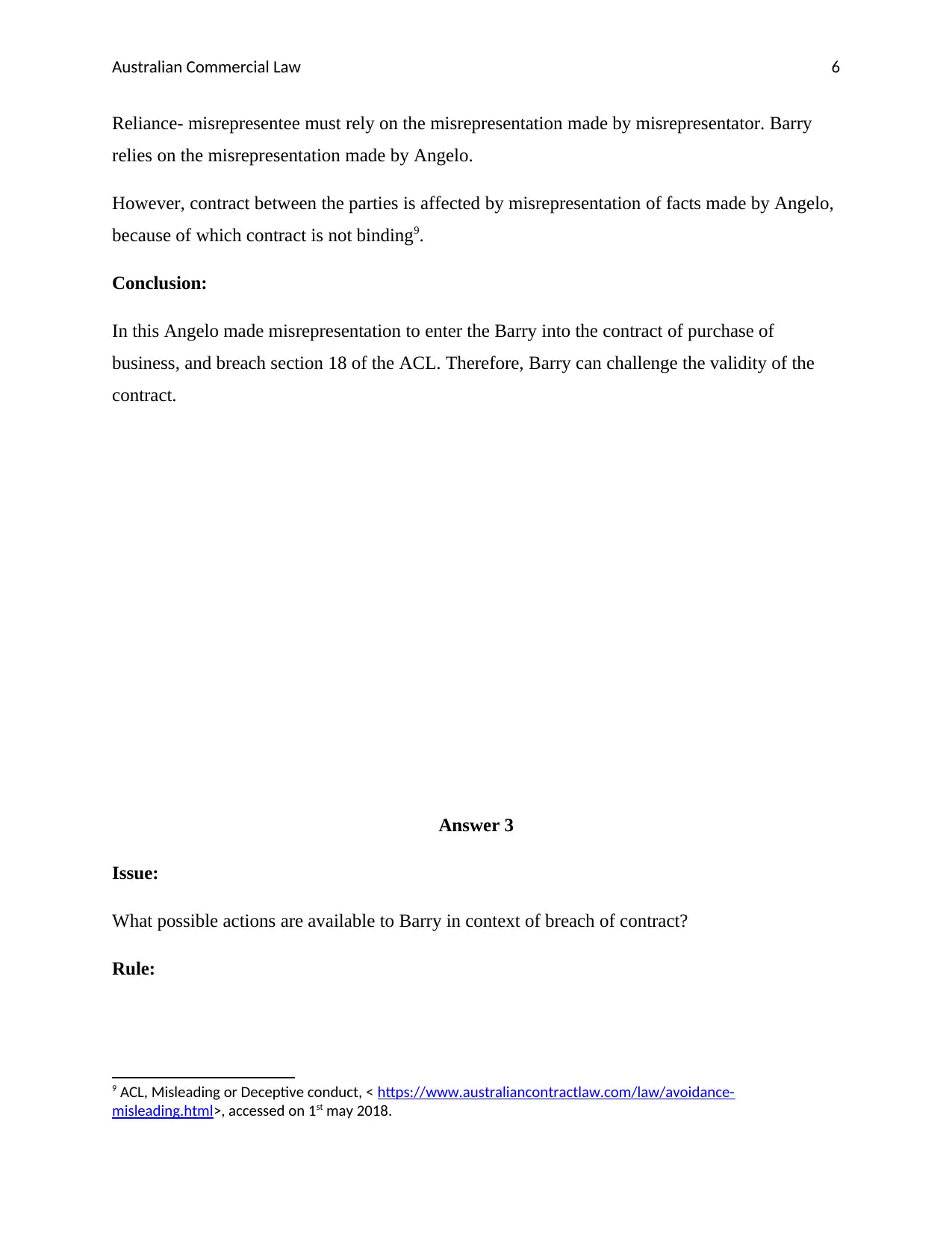
Australian Commercial Law 6
Reliance- misrepresentee must rely on the misrepresentation made by misrepresentator. Barry
relies on the misrepresentation made by Angelo.
However, contract between the parties is affected by misrepresentation of facts made by Angelo,
because of which contract is not binding9.
Conclusion:
In this Angelo made misrepresentation to enter the Barry into the contract of purchase of
business, and breach section 18 of the ACL. Therefore, Barry can challenge the validity of the
contract.
Answer 3
Issue:
What possible actions are available to Barry in context of breach of contract?
Rule:
9 ACL, Misleading or Deceptive conduct, < https://www.australiancontractlaw.com/law/avoidance-
misleading.html>, accessed on 1st may 2018.
Reliance- misrepresentee must rely on the misrepresentation made by misrepresentator. Barry
relies on the misrepresentation made by Angelo.
However, contract between the parties is affected by misrepresentation of facts made by Angelo,
because of which contract is not binding9.
Conclusion:
In this Angelo made misrepresentation to enter the Barry into the contract of purchase of
business, and breach section 18 of the ACL. Therefore, Barry can challenge the validity of the
contract.
Answer 3
Issue:
What possible actions are available to Barry in context of breach of contract?
Rule:
9 ACL, Misleading or Deceptive conduct, < https://www.australiancontractlaw.com/law/avoidance-
misleading.html>, accessed on 1st may 2018.
⊘ This is a preview!⊘
Do you want full access?
Subscribe today to unlock all pages.

Trusted by 1+ million students worldwide
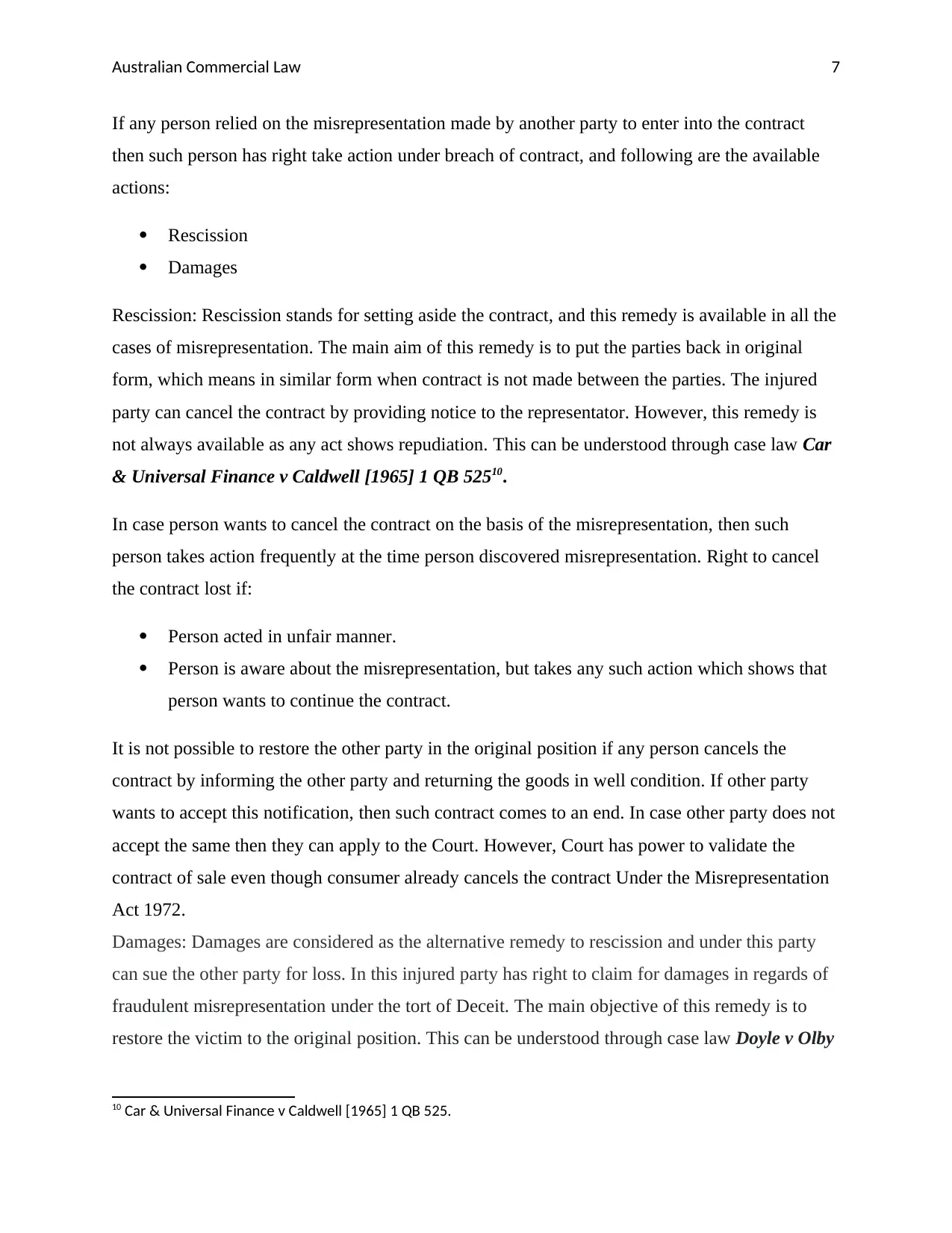
Australian Commercial Law 7
If any person relied on the misrepresentation made by another party to enter into the contract
then such person has right take action under breach of contract, and following are the available
actions:
Rescission
Damages
Rescission: Rescission stands for setting aside the contract, and this remedy is available in all the
cases of misrepresentation. The main aim of this remedy is to put the parties back in original
form, which means in similar form when contract is not made between the parties. The injured
party can cancel the contract by providing notice to the representator. However, this remedy is
not always available as any act shows repudiation. This can be understood through case law Car
& Universal Finance v Caldwell [1965] 1 QB 52510.
In case person wants to cancel the contract on the basis of the misrepresentation, then such
person takes action frequently at the time person discovered misrepresentation. Right to cancel
the contract lost if:
Person acted in unfair manner.
Person is aware about the misrepresentation, but takes any such action which shows that
person wants to continue the contract.
It is not possible to restore the other party in the original position if any person cancels the
contract by informing the other party and returning the goods in well condition. If other party
wants to accept this notification, then such contract comes to an end. In case other party does not
accept the same then they can apply to the Court. However, Court has power to validate the
contract of sale even though consumer already cancels the contract Under the Misrepresentation
Act 1972.
Damages: Damages are considered as the alternative remedy to rescission and under this party
can sue the other party for loss. In this injured party has right to claim for damages in regards of
fraudulent misrepresentation under the tort of Deceit. The main objective of this remedy is to
restore the victim to the original position. This can be understood through case law Doyle v Olby
10 Car & Universal Finance v Caldwell [1965] 1 QB 525.
If any person relied on the misrepresentation made by another party to enter into the contract
then such person has right take action under breach of contract, and following are the available
actions:
Rescission
Damages
Rescission: Rescission stands for setting aside the contract, and this remedy is available in all the
cases of misrepresentation. The main aim of this remedy is to put the parties back in original
form, which means in similar form when contract is not made between the parties. The injured
party can cancel the contract by providing notice to the representator. However, this remedy is
not always available as any act shows repudiation. This can be understood through case law Car
& Universal Finance v Caldwell [1965] 1 QB 52510.
In case person wants to cancel the contract on the basis of the misrepresentation, then such
person takes action frequently at the time person discovered misrepresentation. Right to cancel
the contract lost if:
Person acted in unfair manner.
Person is aware about the misrepresentation, but takes any such action which shows that
person wants to continue the contract.
It is not possible to restore the other party in the original position if any person cancels the
contract by informing the other party and returning the goods in well condition. If other party
wants to accept this notification, then such contract comes to an end. In case other party does not
accept the same then they can apply to the Court. However, Court has power to validate the
contract of sale even though consumer already cancels the contract Under the Misrepresentation
Act 1972.
Damages: Damages are considered as the alternative remedy to rescission and under this party
can sue the other party for loss. In this injured party has right to claim for damages in regards of
fraudulent misrepresentation under the tort of Deceit. The main objective of this remedy is to
restore the victim to the original position. This can be understood through case law Doyle v Olby
10 Car & Universal Finance v Caldwell [1965] 1 QB 525.
Paraphrase This Document
Need a fresh take? Get an instant paraphrase of this document with our AI Paraphraser
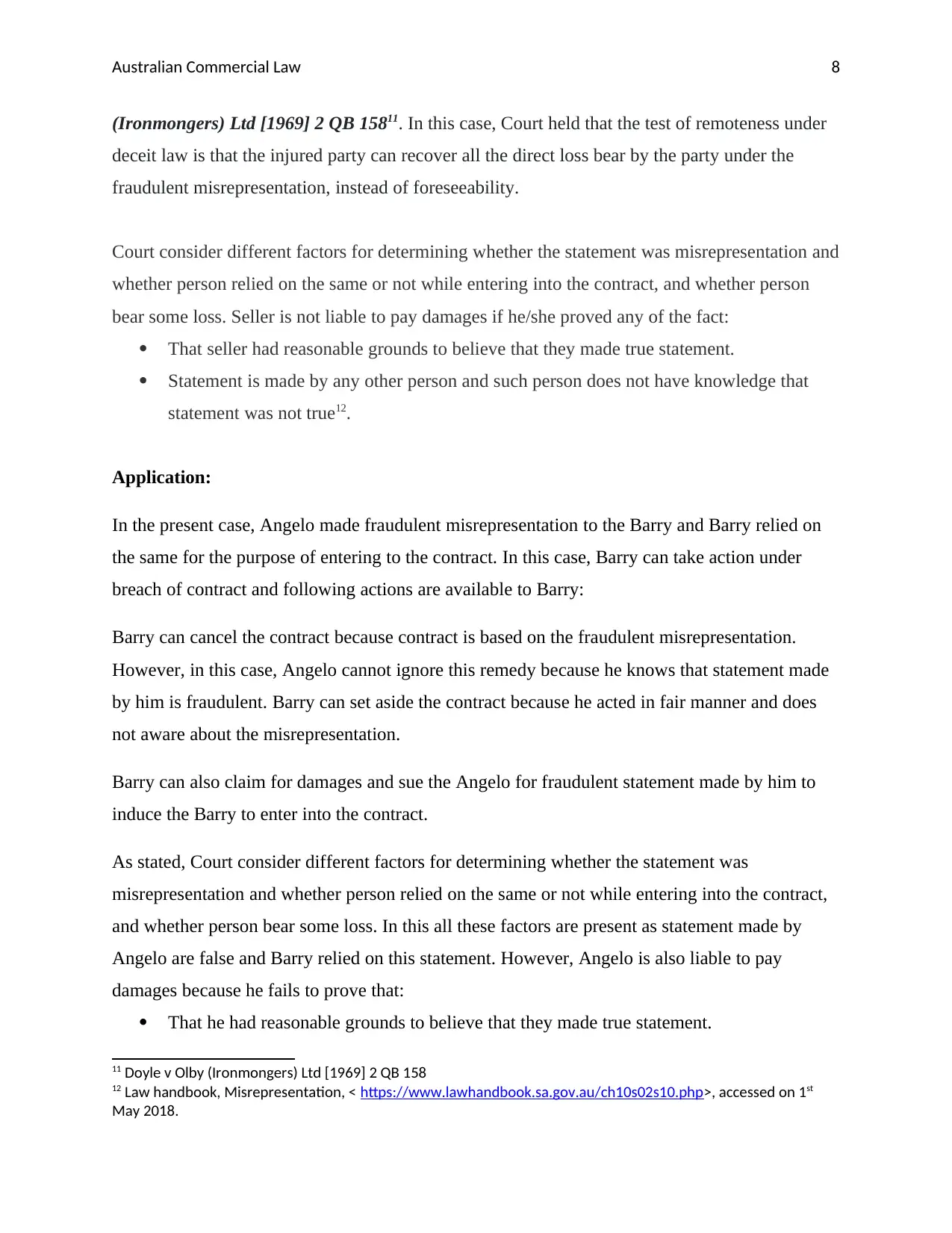
Australian Commercial Law 8
(Ironmongers) Ltd [1969] 2 QB 15811. In this case, Court held that the test of remoteness under
deceit law is that the injured party can recover all the direct loss bear by the party under the
fraudulent misrepresentation, instead of foreseeability.
Court consider different factors for determining whether the statement was misrepresentation and
whether person relied on the same or not while entering into the contract, and whether person
bear some loss. Seller is not liable to pay damages if he/she proved any of the fact:
That seller had reasonable grounds to believe that they made true statement.
Statement is made by any other person and such person does not have knowledge that
statement was not true12.
Application:
In the present case, Angelo made fraudulent misrepresentation to the Barry and Barry relied on
the same for the purpose of entering to the contract. In this case, Barry can take action under
breach of contract and following actions are available to Barry:
Barry can cancel the contract because contract is based on the fraudulent misrepresentation.
However, in this case, Angelo cannot ignore this remedy because he knows that statement made
by him is fraudulent. Barry can set aside the contract because he acted in fair manner and does
not aware about the misrepresentation.
Barry can also claim for damages and sue the Angelo for fraudulent statement made by him to
induce the Barry to enter into the contract.
As stated, Court consider different factors for determining whether the statement was
misrepresentation and whether person relied on the same or not while entering into the contract,
and whether person bear some loss. In this all these factors are present as statement made by
Angelo are false and Barry relied on this statement. However, Angelo is also liable to pay
damages because he fails to prove that:
That he had reasonable grounds to believe that they made true statement.
11 Doyle v Olby (Ironmongers) Ltd [1969] 2 QB 158
12 Law handbook, Misrepresentation, < https://www.lawhandbook.sa.gov.au/ch10s02s10.php>, accessed on 1st
May 2018.
(Ironmongers) Ltd [1969] 2 QB 15811. In this case, Court held that the test of remoteness under
deceit law is that the injured party can recover all the direct loss bear by the party under the
fraudulent misrepresentation, instead of foreseeability.
Court consider different factors for determining whether the statement was misrepresentation and
whether person relied on the same or not while entering into the contract, and whether person
bear some loss. Seller is not liable to pay damages if he/she proved any of the fact:
That seller had reasonable grounds to believe that they made true statement.
Statement is made by any other person and such person does not have knowledge that
statement was not true12.
Application:
In the present case, Angelo made fraudulent misrepresentation to the Barry and Barry relied on
the same for the purpose of entering to the contract. In this case, Barry can take action under
breach of contract and following actions are available to Barry:
Barry can cancel the contract because contract is based on the fraudulent misrepresentation.
However, in this case, Angelo cannot ignore this remedy because he knows that statement made
by him is fraudulent. Barry can set aside the contract because he acted in fair manner and does
not aware about the misrepresentation.
Barry can also claim for damages and sue the Angelo for fraudulent statement made by him to
induce the Barry to enter into the contract.
As stated, Court consider different factors for determining whether the statement was
misrepresentation and whether person relied on the same or not while entering into the contract,
and whether person bear some loss. In this all these factors are present as statement made by
Angelo are false and Barry relied on this statement. However, Angelo is also liable to pay
damages because he fails to prove that:
That he had reasonable grounds to believe that they made true statement.
11 Doyle v Olby (Ironmongers) Ltd [1969] 2 QB 158
12 Law handbook, Misrepresentation, < https://www.lawhandbook.sa.gov.au/ch10s02s10.php>, accessed on 1st
May 2018.
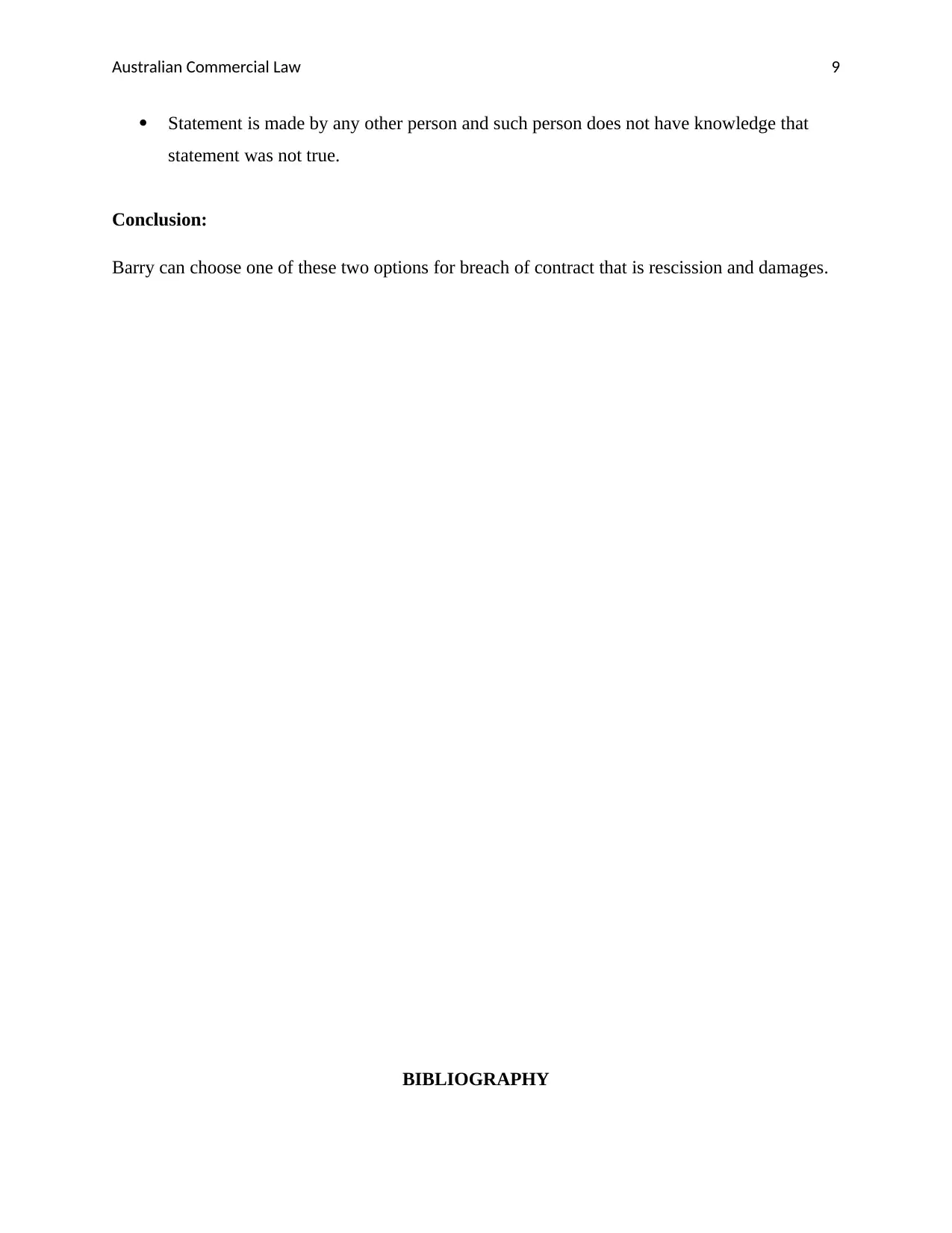
Australian Commercial Law 9
Statement is made by any other person and such person does not have knowledge that
statement was not true.
Conclusion:
Barry can choose one of these two options for breach of contract that is rescission and damages.
BIBLIOGRAPHY
Statement is made by any other person and such person does not have knowledge that
statement was not true.
Conclusion:
Barry can choose one of these two options for breach of contract that is rescission and damages.
BIBLIOGRAPHY
⊘ This is a preview!⊘
Do you want full access?
Subscribe today to unlock all pages.

Trusted by 1+ million students worldwide
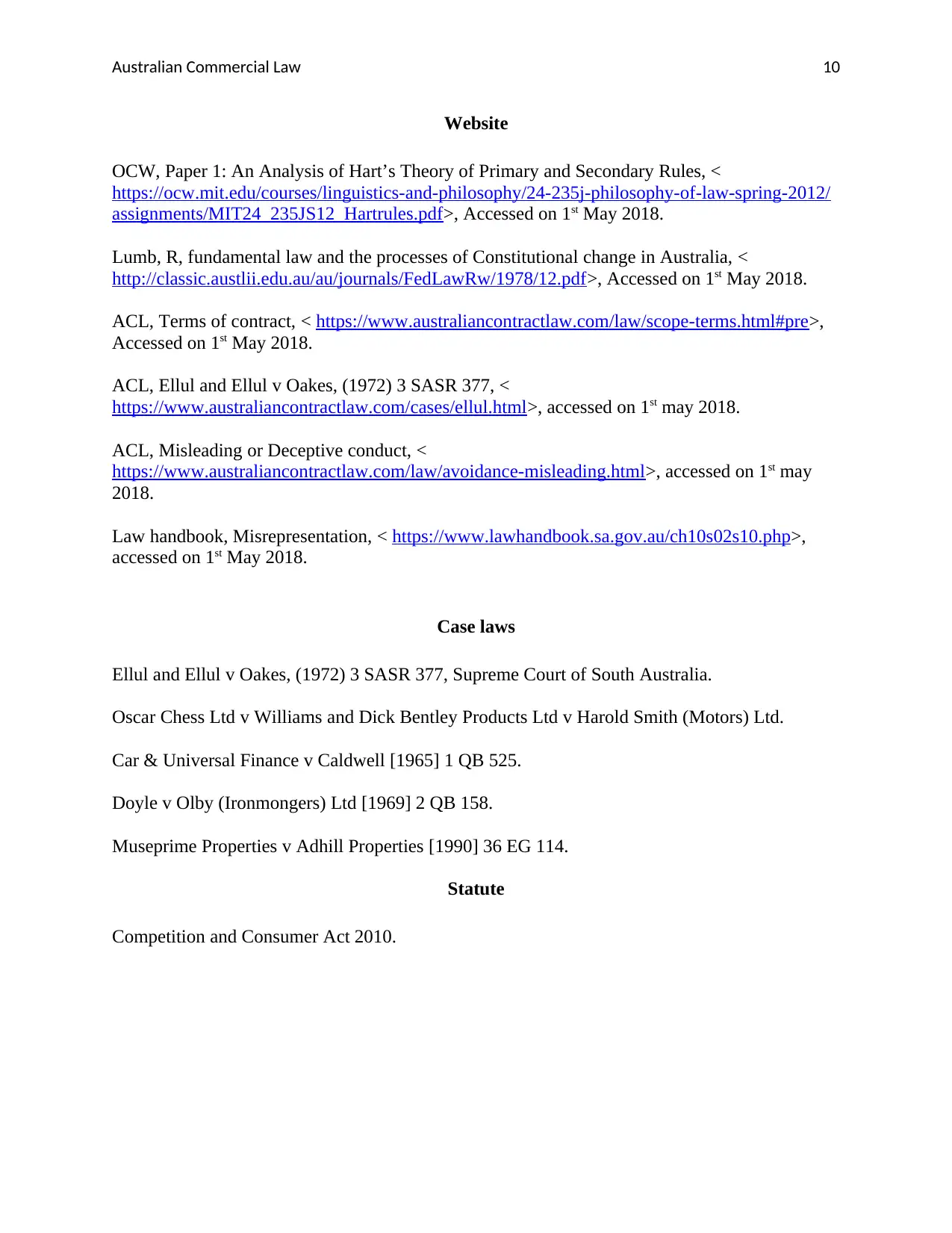
Australian Commercial Law 10
Website
OCW, Paper 1: An Analysis of Hart’s Theory of Primary and Secondary Rules, <
https://ocw.mit.edu/courses/linguistics-and-philosophy/24-235j-philosophy-of-law-spring-2012/
assignments/MIT24_235JS12_Hartrules.pdf>, Accessed on 1st May 2018.
Lumb, R, fundamental law and the processes of Constitutional change in Australia, <
http://classic.austlii.edu.au/au/journals/FedLawRw/1978/12.pdf>, Accessed on 1st May 2018.
ACL, Terms of contract, < https://www.australiancontractlaw.com/law/scope-terms.html#pre>,
Accessed on 1st May 2018.
ACL, Ellul and Ellul v Oakes, (1972) 3 SASR 377, <
https://www.australiancontractlaw.com/cases/ellul.html>, accessed on 1st may 2018.
ACL, Misleading or Deceptive conduct, <
https://www.australiancontractlaw.com/law/avoidance-misleading.html>, accessed on 1st may
2018.
Law handbook, Misrepresentation, < https://www.lawhandbook.sa.gov.au/ch10s02s10.php>,
accessed on 1st May 2018.
Case laws
Ellul and Ellul v Oakes, (1972) 3 SASR 377, Supreme Court of South Australia.
Oscar Chess Ltd v Williams and Dick Bentley Products Ltd v Harold Smith (Motors) Ltd.
Car & Universal Finance v Caldwell [1965] 1 QB 525.
Doyle v Olby (Ironmongers) Ltd [1969] 2 QB 158.
Museprime Properties v Adhill Properties [1990] 36 EG 114.
Statute
Competition and Consumer Act 2010.
Website
OCW, Paper 1: An Analysis of Hart’s Theory of Primary and Secondary Rules, <
https://ocw.mit.edu/courses/linguistics-and-philosophy/24-235j-philosophy-of-law-spring-2012/
assignments/MIT24_235JS12_Hartrules.pdf>, Accessed on 1st May 2018.
Lumb, R, fundamental law and the processes of Constitutional change in Australia, <
http://classic.austlii.edu.au/au/journals/FedLawRw/1978/12.pdf>, Accessed on 1st May 2018.
ACL, Terms of contract, < https://www.australiancontractlaw.com/law/scope-terms.html#pre>,
Accessed on 1st May 2018.
ACL, Ellul and Ellul v Oakes, (1972) 3 SASR 377, <
https://www.australiancontractlaw.com/cases/ellul.html>, accessed on 1st may 2018.
ACL, Misleading or Deceptive conduct, <
https://www.australiancontractlaw.com/law/avoidance-misleading.html>, accessed on 1st may
2018.
Law handbook, Misrepresentation, < https://www.lawhandbook.sa.gov.au/ch10s02s10.php>,
accessed on 1st May 2018.
Case laws
Ellul and Ellul v Oakes, (1972) 3 SASR 377, Supreme Court of South Australia.
Oscar Chess Ltd v Williams and Dick Bentley Products Ltd v Harold Smith (Motors) Ltd.
Car & Universal Finance v Caldwell [1965] 1 QB 525.
Doyle v Olby (Ironmongers) Ltd [1969] 2 QB 158.
Museprime Properties v Adhill Properties [1990] 36 EG 114.
Statute
Competition and Consumer Act 2010.
1 out of 10
Related Documents
Your All-in-One AI-Powered Toolkit for Academic Success.
+13062052269
info@desklib.com
Available 24*7 on WhatsApp / Email
![[object Object]](/_next/static/media/star-bottom.7253800d.svg)
Unlock your academic potential
Copyright © 2020–2025 A2Z Services. All Rights Reserved. Developed and managed by ZUCOL.





